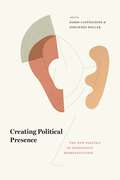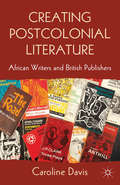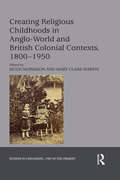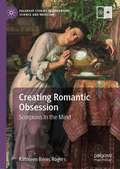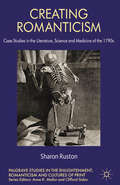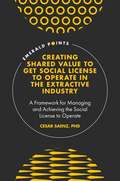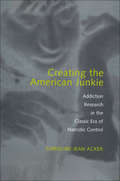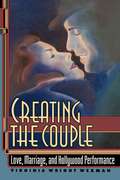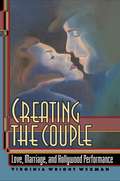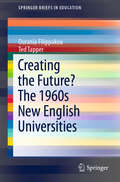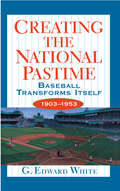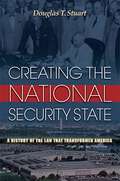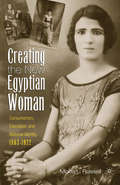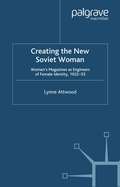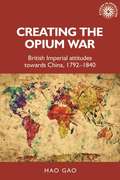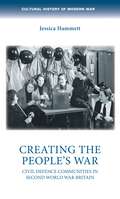- Table View
- List View
Creating Political Presence: The New Politics of Democratic Representation
by Dario Castiglione Johannes PollakFor at least two centuries, democratic representation has been at the center of debate. Should elected representatives express the views of the majority, or do they have the discretion to interpret their constituents’ interests? How can representatives balance the desires of their parties and their electors? What should be done to strengthen the representation of groups that have been excluded from the political system? Representative democracy itself remains frequently contested, regarded as incapable of reflecting the will of the masses, or inadequate for today’s global governance. Recently, however, this view of democratic representation has been under attack for its failure to capture the performative and constructive elements of the process of representation, and a new literature more attentive to these aspects of the relationship between representatives and the represented has arisen. In Creating Political Presence, a diverse and international group of scholars explores the implications of such a turn. Two broad, overlapping perspectives emerge. In the first section, the contributions investigate how political representation relates to empowerment, either facilitating or interfering with the capacity of citizens to develop autonomous judgment in collective decision making. Contributions in the second section look at representation from the perspective of inclusion, focusing on how representative relationships and claims articulate the demands of those who are excluded or have no voice. The final section examines political representation from a more systemic perspective, exploring its broader environmental conditions and the way it acquires democratic legitimacy.
Creating Political Presence: The New Politics of Democratic Representation
by Dario Castiglione Johannes PollakFor at least two centuries, democratic representation has been at the center of debate. Should elected representatives express the views of the majority, or do they have the discretion to interpret their constituents’ interests? How can representatives balance the desires of their parties and their electors? What should be done to strengthen the representation of groups that have been excluded from the political system? Representative democracy itself remains frequently contested, regarded as incapable of reflecting the will of the masses, or inadequate for today’s global governance. Recently, however, this view of democratic representation has been under attack for its failure to capture the performative and constructive elements of the process of representation, and a new literature more attentive to these aspects of the relationship between representatives and the represented has arisen. In Creating Political Presence, a diverse and international group of scholars explores the implications of such a turn. Two broad, overlapping perspectives emerge. In the first section, the contributions investigate how political representation relates to empowerment, either facilitating or interfering with the capacity of citizens to develop autonomous judgment in collective decision making. Contributions in the second section look at representation from the perspective of inclusion, focusing on how representative relationships and claims articulate the demands of those who are excluded or have no voice. The final section examines political representation from a more systemic perspective, exploring its broader environmental conditions and the way it acquires democratic legitimacy.
Creating Political Presence: The New Politics of Democratic Representation
by Dario Castiglione Johannes PollakFor at least two centuries, democratic representation has been at the center of debate. Should elected representatives express the views of the majority, or do they have the discretion to interpret their constituents’ interests? How can representatives balance the desires of their parties and their electors? What should be done to strengthen the representation of groups that have been excluded from the political system? Representative democracy itself remains frequently contested, regarded as incapable of reflecting the will of the masses, or inadequate for today’s global governance. Recently, however, this view of democratic representation has been under attack for its failure to capture the performative and constructive elements of the process of representation, and a new literature more attentive to these aspects of the relationship between representatives and the represented has arisen. In Creating Political Presence, a diverse and international group of scholars explores the implications of such a turn. Two broad, overlapping perspectives emerge. In the first section, the contributions investigate how political representation relates to empowerment, either facilitating or interfering with the capacity of citizens to develop autonomous judgment in collective decision making. Contributions in the second section look at representation from the perspective of inclusion, focusing on how representative relationships and claims articulate the demands of those who are excluded or have no voice. The final section examines political representation from a more systemic perspective, exploring its broader environmental conditions and the way it acquires democratic legitimacy.
Creating Political Presence: The New Politics of Democratic Representation
For at least two centuries, democratic representation has been at the center of debate. Should elected representatives express the views of the majority, or do they have the discretion to interpret their constituents’ interests? How can representatives balance the desires of their parties and their electors? What should be done to strengthen the representation of groups that have been excluded from the political system? Representative democracy itself remains frequently contested, regarded as incapable of reflecting the will of the masses, or inadequate for today’s global governance. Recently, however, this view of democratic representation has been under attack for its failure to capture the performative and constructive elements of the process of representation, and a new literature more attentive to these aspects of the relationship between representatives and the represented has arisen. In Creating Political Presence, a diverse and international group of scholars explores the implications of such a turn. Two broad, overlapping perspectives emerge. In the first section, the contributions investigate how political representation relates to empowerment, either facilitating or interfering with the capacity of citizens to develop autonomous judgment in collective decision making. Contributions in the second section look at representation from the perspective of inclusion, focusing on how representative relationships and claims articulate the demands of those who are excluded or have no voice. The final section examines political representation from a more systemic perspective, exploring its broader environmental conditions and the way it acquires democratic legitimacy.
Creating Postcolonial Literature: African Writers and British Publishers
by C. DavisUsing case studies, this book explores the publishing of African literature, addressing the construction of literary value, relationships between African writers and British publishers, and importance of the African market. It analyses the historical, political and economic conditions framing the emergence of postcolonial literature.
Creating Religious Childhoods in Anglo-World and British Colonial Contexts, 1800-1950 (Studies in Childhood, 1700 to the Present)
by Hugh Morrison Mary Clare MartinDrawing on examples from British world expressions of Christianity, this collection further greater understanding of religion as a critical element of modern children’s and young people’s history. It builds on emerging scholarship that challenges the view that religion had a solely negative impact on nineteenth- and twentieth-century children, or that ‘secularization’ is the only lens to apply to childhood and religion. Putting forth the argument that religion was an abiding influence among British world children throughout the nineteenth and most of the twentieth centuries, this volume places ‘religion’ at the center of analysis and discussion. At the same time, it positions the religious factor within a broader social and cultural framework. The essays focus on the historical contexts in which religion was formative for children in various ‘British’ settings denoted as ‘Anglo’ or ‘colonial’ during the nineteenth and early- to mid-twentieth centuries. These contexts include mission fields, churches, families, Sunday schools, camps, schools and youth movements. Together they are treated as ‘sites’ in which religion contributed to identity formation, albeit in different ways relating to such factors as gender, race, disability and denomination. The contributors develop this subject for childhoods that were experienced largely, but not exclusively, outside the ‘metropole’, in a diversity of geographical settings. By extending the geographic range, even within the British world, it provides a more rounded perspective on children’s global engagement with religion.
Creating Religious Childhoods in Anglo-World and British Colonial Contexts, 1800-1950 (Studies in Childhood, 1700 to the Present)
by Hugh Morrison Mary Clare MartinDrawing on examples from British world expressions of Christianity, this collection further greater understanding of religion as a critical element of modern children’s and young people’s history. It builds on emerging scholarship that challenges the view that religion had a solely negative impact on nineteenth- and twentieth-century children, or that ‘secularization’ is the only lens to apply to childhood and religion. Putting forth the argument that religion was an abiding influence among British world children throughout the nineteenth and most of the twentieth centuries, this volume places ‘religion’ at the center of analysis and discussion. At the same time, it positions the religious factor within a broader social and cultural framework. The essays focus on the historical contexts in which religion was formative for children in various ‘British’ settings denoted as ‘Anglo’ or ‘colonial’ during the nineteenth and early- to mid-twentieth centuries. These contexts include mission fields, churches, families, Sunday schools, camps, schools and youth movements. Together they are treated as ‘sites’ in which religion contributed to identity formation, albeit in different ways relating to such factors as gender, race, disability and denomination. The contributors develop this subject for childhoods that were experienced largely, but not exclusively, outside the ‘metropole’, in a diversity of geographical settings. By extending the geographic range, even within the British world, it provides a more rounded perspective on children’s global engagement with religion.
Creating Romantic Obsession: Scorpions in the Mind (Palgrave Studies in Literature, Science and Medicine)
by Kathleen Béres RogersMost of us have, at one time, been obsessed with something, but how did obsession become a mental illness? This book examines literary, medical, and philosophical texts to argue that what we call obsession became a disease in the Romantic era and reflects the era’s anxieties. Using a number of literary texts, some well-known (like Mary Shelley’s 1818 Frankenstein and Edgar Allan Poe’s 1843 “The Tell Tale Heart”) and some not (like Charlotte Dacre’s 1811 The Passions and Charles Brockden Brown’s 1787 Edgar Huntly), the book looks at “vigilia”, an overly intense curiosity, “intellectual monomania”, an obsession with study, “nymphomania” and “erotomania”, gendered forms of desire, “revolutiana”, an obsession with sublime violence and military service, and “ideality,” an obsession with an idea. The coda argues that traces of these Romantic constructs can be seen in popular accounts of obsession today.
Creating Romanticism: Case Studies in the Literature, Science and Medicine of the 1790s (Palgrave Studies in the Enlightenment, Romanticism and Cultures of Print)
by S. RustonThis book argues that the term 'Romanticism' should be more culturally-inclusive, recognizing the importance of scientific and medical ideas that helped shape some of the key concepts of the period, such as natural rights, the creative imagination and the sublime.
Creating Shared Value to get Social License to Operate in the Extractive Industry: A Framework for Managing and Achieving the Social License to Operate (Emerald Points)
by Cesar SaenzNo matter how hard employees work, an organization is in real trouble if strategic decisions are not made effectively. Doing the right things (effectiveness) is more important than doing things right (efficiency). Creating Shared Value to get Social License to Operate in the Extractive Industry showcases concepts and tools to make strategic decisions that determine the future direction and competitive position of extractive company enterprises to create shared value to earn SLO. Exploring a challenging and exciting keystone topic, Creating Shared Value to get Social License to Operate in the Extractive Industry presents techniques and models that will enable you to actually formulate, implement, and evaluate strategies to shared value to earn SLO.
Creating Shared Value to get Social License to Operate in the Extractive Industry: A Framework for Managing and Achieving the Social License to Operate (Emerald Points)
by Cesar SaenzNo matter how hard employees work, an organization is in real trouble if strategic decisions are not made effectively. Doing the right things (effectiveness) is more important than doing things right (efficiency). Creating Shared Value to get Social License to Operate in the Extractive Industry showcases concepts and tools to make strategic decisions that determine the future direction and competitive position of extractive company enterprises to create shared value to earn SLO. Exploring a challenging and exciting keystone topic, Creating Shared Value to get Social License to Operate in the Extractive Industry presents techniques and models that will enable you to actually formulate, implement, and evaluate strategies to shared value to earn SLO.
Creating the American Junkie: Addiction Research in the Classic Era of Narcotic Control
by Caroline Jean AckerHeroin was only one drug among many that worried Progressive Era anti-vice reformers, but by the mid-twentieth century, heroin addiction came to symbolize irredeemable deviance. Creating the American Junkie examines how psychiatrists and psychologists produced a construction of opiate addicts as deviants with inherently flawed personalities caught in the grip of a dependency from which few would ever escape. Their portrayal of the tough urban addict helped bolster the federal government's policy of drug prohibition and created a social context that made the life of the American heroin addict, or junkie, more, not less, precarious in the wake of Progressive Era reforms.Weaving together the accounts of addicts and researchers, Acker examines how the construction of addiction in the early twentieth century was strongly influenced by the professional concerns of psychiatrists seeking to increase their medical authority; by the disciplinary ambitions of pharmacologists to build a drug development infrastructure; and by the American Medical Association's campaign to reduce prescriptions of opiates and to absolve physicians in private practice from the necessity of treating difficult addicts as patients. In contrast, early sociological studies of heroin addicts formed a basis for criticizing the criminalization of addiction. By 1940, Acker concludes, a particular configuration of ideas about opiate addiction was firmly in place and remained essentially stable until the enormous demographic changes in drug use of the 1960s and 1970s prompted changes in the understanding of addiction—and in public policy.
Creating the Couple: Love, Marriage, and Hollywood Performance (PDF)
by Virginia Wexman WexmanWho decides how, when, and where Americans fall in love and get married? Virginia Wexman's acute observations about movie stars and acting techniques show that Hollywood has often had the most powerful voice in demonstrating socially sanctioned ways of becoming a couple. Until now serious film critics have paid little attention to the impact of performance styles on American romance, and have often treated "patriarchy," "sexuality," and the "couple" as monolithic and unproblematic concepts. Wexman, however, shows how these notions have been periodically transformed in close association with the appearance, behavior, and persona of the stars of films such as The Maltese Falcon, The Big Sleep, Way Down East, The Man Who Shot Liberty Valance, Sunset Boulevard, On the Waterfront, Nashville, House of Games, and Do the Right Thing. The author focuses first on the way in which traditional marriage norms relate to authorship (the Griffith-Gish collaboration) and genre (John Wayne and the Western). Looking at male and female stardom in terms of the development of "companionate marriage," she discusses the love goddess and the impact of method acting on Hollywood's ideals of maleness. Finally she considers the recent breakdown of the ideal of monogamous marriage in relation to Hollywood's experimentation with self-reflexive acting styles. Creating the Couple is must reading for film scholars and enthusiasts, and it will fascinate everyone interested in the changing relationships of men and women in modern culture.
Creating the Couple: Love, Marriage, and Hollywood Performance
by Virginia Wexman WexmanWho decides how, when, and where Americans fall in love and get married? Virginia Wexman's acute observations about movie stars and acting techniques show that Hollywood has often had the most powerful voice in demonstrating socially sanctioned ways of becoming a couple. Until now serious film critics have paid little attention to the impact of performance styles on American romance, and have often treated "patriarchy," "sexuality," and the "couple" as monolithic and unproblematic concepts. Wexman, however, shows how these notions have been periodically transformed in close association with the appearance, behavior, and persona of the stars of films such as The Maltese Falcon, The Big Sleep, Way Down East, The Man Who Shot Liberty Valance, Sunset Boulevard, On the Waterfront, Nashville, House of Games, and Do the Right Thing. The author focuses first on the way in which traditional marriage norms relate to authorship (the Griffith-Gish collaboration) and genre (John Wayne and the Western). Looking at male and female stardom in terms of the development of "companionate marriage," she discusses the love goddess and the impact of method acting on Hollywood's ideals of maleness. Finally she considers the recent breakdown of the ideal of monogamous marriage in relation to Hollywood's experimentation with self-reflexive acting styles. Creating the Couple is must reading for film scholars and enthusiasts, and it will fascinate everyone interested in the changing relationships of men and women in modern culture.
Creating the Future? The 1960s New English Universities (SpringerBriefs in Education)
by Ourania Filippakou Ted TapperThis book examines the developments of the UK Higher Education system, from a time of donnish dominion, progressive decline and the increasing role of the market via the introduction of tuition fees. It offers a protracted empirical analysis of the seven new English universities of the 1960s: the Universities of East Anglia, Essex, Kent, Lancaster, Sussex, Warwick and York. It explores the creation of these universities and investigates how they each responded to a number of centrally-imposed initiatives for change in UK higher education that have emerged since their foundation. It discusses changes in system governance and how the Higher Education policies it generated have impacted upon a particular segment of the English university model. Divided into three parts, the book first deals with such topics as the control the University Grants’ Committee exercised in its heyday and how they initiated the launch of new universities. It then examines policy initiatives on government cuts on grants, research assessment exercises, quality assurance procedures and student tuition fees. The last part takes a broader approach to change by studying the significance and demise of Mission Groups, a changing system of Higher Education and more general changes regarding the state, the market and governance.
Creating the National Pastime: Baseball Transforms Itself, 1903-1953
by G. Edward WhiteAt a time when many baseball fans wish for the game to return to a purer past, G. Edward White shows how seemingly irrational business decisions, inspired in part by the self-interest of the owners but also by their nostalgia for the game, transformed baseball into the national pastime. Not simply a professional sport, baseball has been treated as a focus of childhood rituals and an emblem of American individuality and fair play throughout much of the twentieth century. It started out, however, as a marginal urban sport associated with drinking and gambling. White describes its progression to an almost mythic status as an idyllic game, popular among people of all ages and classes. He then recounts the owner's efforts, often supported by the legal system, to preserve this image. Baseball grew up in the midst of urban industrialization during the Progressive Era, and the emerging steel and concrete baseball parks encapsulated feelings of neighborliness and associations with the rural leisure of bygone times. According to White, these nostalgic themes, together with personal financial concerns, guided owners toward practices that in retrospect appear unfair to players and detrimental to the progress of the game. Reserve clauses, blacklisting, and limiting franchise territories, for example, were meant to keep a consistent roster of players on a team, build fan loyalty, and maintain the game's local flavor. These practices also violated anti-trust laws and significantly restricted the economic power of the players. Owners vigorously fought against innovations, ranging from the night games and radio broadcasts to the inclusion of African-American players. Nonetheless, the image of baseball as a spirited civic endeavor persisted, even in the face of outright corruption, as witnessed in the courts' leniency toward the participants in the Black Sox scandal of 1919. White's story of baseball is intertwined with changes in technology and business in America and with changing attitudes toward race and ethnicity. The time is fast approaching, he concludes, when we must consider whether baseball is still regarded as the national pastime and whether protecting its image is worth the effort.
Creating the National Pastime: Baseball Transforms Itself, 1903-1953 (PDF)
by G. Edward WhiteAt a time when many baseball fans wish for the game to return to a purer past, G. Edward White shows how seemingly irrational business decisions, inspired in part by the self-interest of the owners but also by their nostalgia for the game, transformed baseball into the national pastime. Not simply a professional sport, baseball has been treated as a focus of childhood rituals and an emblem of American individuality and fair play throughout much of the twentieth century. It started out, however, as a marginal urban sport associated with drinking and gambling. White describes its progression to an almost mythic status as an idyllic game, popular among people of all ages and classes. He then recounts the owner's efforts, often supported by the legal system, to preserve this image. Baseball grew up in the midst of urban industrialization during the Progressive Era, and the emerging steel and concrete baseball parks encapsulated feelings of neighborliness and associations with the rural leisure of bygone times. According to White, these nostalgic themes, together with personal financial concerns, guided owners toward practices that in retrospect appear unfair to players and detrimental to the progress of the game. Reserve clauses, blacklisting, and limiting franchise territories, for example, were meant to keep a consistent roster of players on a team, build fan loyalty, and maintain the game's local flavor. These practices also violated anti-trust laws and significantly restricted the economic power of the players. Owners vigorously fought against innovations, ranging from the night games and radio broadcasts to the inclusion of African-American players. Nonetheless, the image of baseball as a spirited civic endeavor persisted, even in the face of outright corruption, as witnessed in the courts' leniency toward the participants in the Black Sox scandal of 1919. White's story of baseball is intertwined with changes in technology and business in America and with changing attitudes toward race and ethnicity. The time is fast approaching, he concludes, when we must consider whether baseball is still regarded as the national pastime and whether protecting its image is worth the effort.
Creating the National Security State: A History of the Law That Transformed America
by Douglas StuartFor the last sixty years, American foreign and defense policymaking has been dominated by a network of institutions created by one piece of legislation--the 1947 National Security Act. This is the definitive study of the intense political and bureaucratic struggles that surrounded the passage and initial implementation of the law. Focusing on the critical years from 1937 to 1960, Douglas Stuart shows how disputes over the lessons of Pearl Harbor and World War II informed the debates that culminated in the legislation, and how the new national security agencies were subsequently transformed by battles over missions, budgets, and influence during the early cold war. Stuart provides an in-depth account of the fight over Truman's plan for unification of the armed services, demonstrating how this dispute colored debates about institutional reform. He traces the rise of the Office of the Secretary of Defense, the transformation of the CIA, and the institutionalization of the National Security Council. He also illustrates how the development of this network of national security institutions resulted in the progressive marginalization of the State Department. Stuart concludes with some insights that will be of value to anyone interested in the current debate over institutional reform.
Creating the National Security State: A History of the Law That Transformed America (PDF)
by Douglas T. StuartFor the last sixty years, American foreign and defense policymaking has been dominated by a network of institutions created by one piece of legislation--the 1947 National Security Act. This is the definitive study of the intense political and bureaucratic struggles that surrounded the passage and initial implementation of the law. Focusing on the critical years from 1937 to 1960, Douglas Stuart shows how disputes over the lessons of Pearl Harbor and World War II informed the debates that culminated in the legislation, and how the new national security agencies were subsequently transformed by battles over missions, budgets, and influence during the early cold war. Stuart provides an in-depth account of the fight over Truman's plan for unification of the armed services, demonstrating how this dispute colored debates about institutional reform. He traces the rise of the Office of the Secretary of Defense, the transformation of the CIA, and the institutionalization of the National Security Council. He also illustrates how the development of this network of national security institutions resulted in the progressive marginalization of the State Department. Stuart concludes with some insights that will be of value to anyone interested in the current debate over institutional reform.
Creating the New Egyptian Woman: Consumerism, Education, and National Identity, 1863-1922
by M. RussellA "New Woman" was announced in Egypt at the turn of the nineteenth century. With a new genre of prescriptive literature, new products, a new education, and a physically changed home, she increasingly emerged in public life. This book discusses and debates the place of Egyptian women, while focusing on consumerism and education. Russell sheds much-needed light on the struggle for identity in Egypt at a time of considerable flux and tension and provides a powerful angle to explore changing concepts of social dynamics and broader debates of what it meant to be "modern" while retaining local authenticity.
Creating the New Soviet Woman: Women's Magazines as Engineers of Female Identity, 1922-53 (Studies in Russian and East European History and Society)
by L. AttwoodThis book explores the Soviet attempt to propagandise the 'new Soviet woman' through the magazines Rabotnitsa and Krest'yanka from the 1920s to the end of the Stalin era. Balancing work and family did not prove easy in a climate of shifting economic and demographic priorities, and the book charts the periodic changes made to the model.
Creating the Opium War: British imperial attitudes towards China, 1792–1840 (Studies in Imperialism)
by Hao GaoCreating the Opium War examines British imperial attitudes towards China during their early encounters from the Macartney embassy to the outbreak of the Opium War – a deeply consequential event which arguably reshaped relations between China and the West in the next century. It makes the first attempt to bring together the political history of Sino-western relations and the cultural studies of British representations of China, as a new way of explaining the origins of the conflict. The book focuses on a crucial period (1792–1840), which scholars such as Kitson and Markley have recently compared in importance to that of American and French Revolutions. By examining a wealth of primary materials, some in more detail than ever before, this study reveals how the idea of war against China was created out of changing British perceptions of the country.
Creating the Opium War: British imperial attitudes towards China, 1792–1840 (Studies in Imperialism)
by Hao GaoCreating the Opium War examines British imperial attitudes towards China during their early encounters from the Macartney embassy to the outbreak of the Opium War – a deeply consequential event which arguably reshaped relations between China and the West in the next century. It makes the first attempt to bring together the political history of Sino-western relations and the cultural studies of British representations of China, as a new way of explaining the origins of the conflict. The book focuses on a crucial period (1792–1840), which scholars such as Kitson and Markley have recently compared in importance to that of American and French Revolutions. By examining a wealth of primary materials, some in more detail than ever before, this study reveals how the idea of war against China was created out of changing British perceptions of the country.
Creating the Other: Ethnic Conflict & Nationalism in Habsburg Central Europe (Austrian and Habsburg Studies #5)
by Nancy M. WingfieldThe historic myths of a people/nation usually play an important role in the creation and consolidation of the basic concepts from which the self-image of that nation derives. These concepts include not only images of the nation itself, but also images of other peoples. Although the construction of ethnic stereotypes during the "long" nineteenth century initially had other functions than simply the homogenization of the particular culture and the exclusion of "others" from the public sphere, the evaluation of peoples according to criteria that included "level of civilization" yielded "rankings" of ethnic groups within the Habsburg Monarchy. That provided the basis for later, more divisive ethnic characterizations of exclusive nationalism, as addressed in this volume that examines the roots and results of ethnic, nationalist, and racial conflict in the region from a variety of historical and theoretical perspectives.
Creating the people’s war: Civil defence communities in Second World War Britain (Cultural History of Modern War)
by Jessica HammettWhy has the ‘people’s war’ been such a durable and attractive myth? Creating the people’s war examines how civil defence personnel engaged with this narrative during the war and in the following decades to answer this question. Civil defence was the most significant voluntary organisation of the Second World War, involving millions of men and women of every class, generation and locality in Britain. This book shows how local communities of civil defence personnel co-developed narratives about the value of their work which challenged hierarchies of war service. In their social groups volunteers wrote themselves into the ‘people’s war’ and invested it with meaning, creating national identity from the bottom up. Community was both central to these representations and vital for their production.
